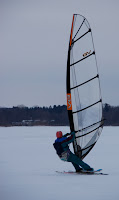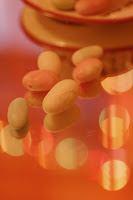For this exercise I had to make two shots: one representing patterns concept and the other - rhythms. For this I decided to use the same object, but from different angles. It was a blue window of a bus stop in the center of Tallinn. I liked the color and the transparency of the window as well as the natural pattern on the window created by the snow.
1. Pattern. I guess that this picture fully covers the concept of pattern. It looks obvious here that the sequence of the snow patterns continues beyond the frame. Though the pieces of show different shapes and sizes, all together they form a pattern on the window.
2. Rhythm. Here I have take a picture of the same object. But additional details make it work as a rhythmic image. Metal bars in the top create an optical bit. Both sequence of snow patterns and and metal bars, leading to the end of the corridor make an eye follow the direction and finally find a way out of the corridor that is difficult to notice when you first look at the picture.
1. Pattern. I guess that this picture fully covers the concept of pattern. It looks obvious here that the sequence of the snow patterns continues beyond the frame. Though the pieces of show different shapes and sizes, all together they form a pattern on the window.
30mm f.4.0 1/100sec
2. Rhythm. Here I have take a picture of the same object. But additional details make it work as a rhythmic image. Metal bars in the top create an optical bit. Both sequence of snow patterns and and metal bars, leading to the end of the corridor make an eye follow the direction and finally find a way out of the corridor that is difficult to notice when you first look at the picture.
38mm f.4.5 1/200sec
When starting this exercise, it was a bit difficult to understand, what is actually meant by rhythm in terms of photography. I did not have this problem with pattern shot, as it is pretty straightforward . However, as soon as I took the picture of the corridor between the glass and the wall, I got it at once, as I really felt, how my eyes were moving all the way along the blue wall and reach the final point at the end of the corridor. A had not also paid attention before to the optical beat question. This task made me think of the picture more in a way one usually thinks of music...









































